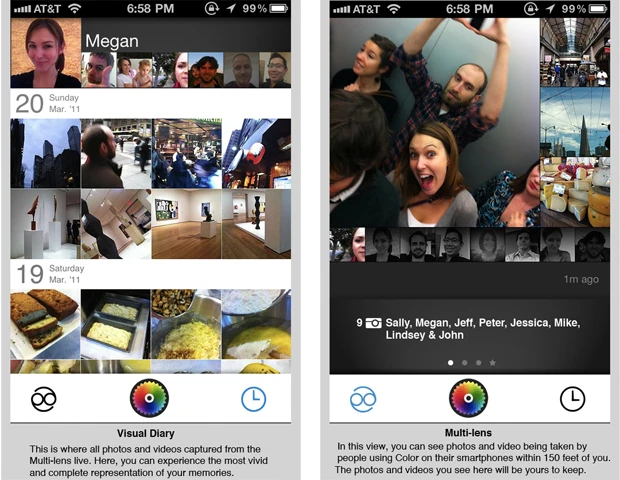
In December, rumors started floating that serial entrepreneur Bill Nguyen, who last sold online music company Lala to Apple in 2009, had purchased the domain Color.com for $350,000. Many wondered: Could this mark Nguyen’s next (and eighth) business venture?
“I did buy it, and I also bought the English spelling, Colour.com,” Nguyen tells Fast Company with a smile. “It’s one of the perks of having done multiple startups: You can buy all the vowels.”

If you can’t already tell, Nguyen is shamelessly confident about his latest product Color, a real-time photo-sharing app that launches today for the iPhone and Android. And so are investors, including Bain and Sequoia Capital, which have already sunk $41 million dollars into the service even before its seen the light of day. Why are so many VCs drooling for Color?
Simply put, Color allows you to share images, videos, and text with other people around you. No login or password is required. Just boot up the app, and you’ll gain access to photos–Nguyen calls it a “visual diary”–from all who are nearby, whether coworkers, neighbors, or the guy you’re riding the elevator with. As Nguyen explains, Color is for the social graph you aren’t already networked up to.
“When I go to a restaurant or public event or cafe, don’t I want to know some of these people around me?” he says. “We thought we could build something that would allow you to get to know everyone else that is not already your Facebook friend.”
So imagine you’re at a family member’s wedding. Bridesmaids are snapping pictures of the groom. A friend is shooting video of your kooky cousin singing along with the band on stage. Your sister is taking pictures on the dance floor. With Facebook, all these images wouldn’t show up online for days, weeks, or months even. On Color, the images are available all in real-time, no hassle.
Nguyen imagines an endless number of use-cases for the service–concerts, restaurants, baseball games–all taking advantage of the app’s impressive proximity algorithms. Nguyen says his team invested a significant amount of time and energy making sure the most relevant photographs are being surfaced. For example, the app features light and noise filters–every so often it will analyze audio snippets or ambient light to make sure you’re in the same bar or apartment or conference room or symphony hall as the other people you’re sharing photos with. Color also takes advantage of smartphones’ GPS, gyroscope, and compass. If you’re at an outdoor concert, for example, Color will not only recognize that thousands of others are uploading images in a cluster, but also that most of the cameras are snapping pics in the same direction–that is, toward a stage. Nguyen says there are between 20 to 40 sensors capturing data to streamline photo-sharing–that’s one reason why the company hired away Dhiren “DJ” Patel, LinkedIn’s (former) chief data officer.
“These pictures are your life, aggregated by other people’s cameras,” Nguyen says.
He calls it “elastic networking,” meaning your social graph is constantly updating based on use, proximity, and interaction. There are no friend requests on Color. There are no profiles. When you get nearby a fellow Color app user, he or she will automatically pop into your social circle, or “visual bulletin.” Depending on how much you interact with this person, Color will automatically adjust who shows up on the bulletin, and who does not.

Color is unlike any social network you’ve experienced before, although you’ll notice elements of Foursquare, Facebook, Instagram, Foodspotting, and others in there. “I think a lot of people touched upon the ideas we’re about to do–we just vertically integrated it all,” says Nguyen, who has some choice words for most of his potential competitors. For one, he knocks other photo-sharing apps as “mice nuts,” and disagrees with Instagram‘s use of trendy filters. “No one sees through filters,” he quips. “I never see life in that perfect sepia moment, and I don’t see things in black and white.”
As for Facebook, Nguyen says he’s started to lose his interest in the service. “It’s become: Look at how amazing my vacation is, or look what great shape I’m in!” he says. “To me, it’s way pithy. It’s just become a highlight reel–and not real life anymore.”
Real-life is exactly what Color hopes to deliver, with a hint of accountability. On other social networks, no one is held accountable for any photo uploaded–one can simply keep albums private or create a fake identity. On Color, your visual diary will follow you wherever you go, whether at a party, at work, or in the classroom. So you might think twice about snapping a pic of that Four Loko funnel attempt. “The beauty of this thing is that it’s completely public,” Nguyen says. “You have to think of it just like Twitter.”
And perhaps it’s no coincidence Nguyen makes the comparison to Twitter. While not delving into too much detail, Nguyen hints, “We think we have a way of introducing Color to 200 million people all at once.”
You mean on Twitter?
“Possibly,” he answers. “Think about how amazing Twitter’s potential is. Think about what happened in Egypt. You have this amazing reporter for, say, The Times, and she’s there, and she’s taking images of what happens. But all her images are solo. Imagine if she tweeted, and every picture around her was marked for a tweet–she didn’t have to upload anything. Imagine the concept of tweeting not just by yourself–but tweeting with other people.”
That may only be food for thought. For now, Nguyen, pictured, is just focused on making sure Color is the success its backers believe it will be.

Recognize your brand’s excellence by applying to this year’s Brands That Matter Awards before the early-rate deadline, May 3.